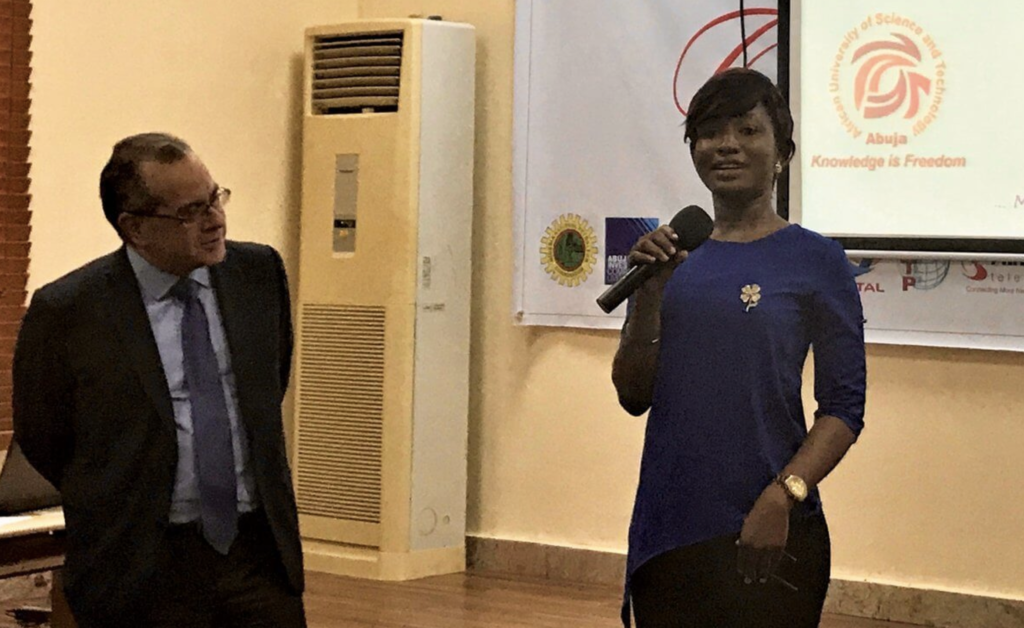
Breast cancer is something far too many families have a personal connection with. Many women know either a mother, aunt, sister, cousin or friend who has suffered from this disease. Many of whom have suffered even during the therapy. But a young Black woman, Sandra Musujusu, has developed an alternative treatment for a subtype of breast cancer commonly found in Black women.
“My research is actually centered on the development of biodegradable polymers for treatment of breast cancer,” Musujusu told the Tribune. “I will be focusing on triple-negative breast cancer, which is actually the aggressive subtype of breast cancer that is common with women from African ancestry.”
Mususjusu shared her alternative treatment for breast cancer with Dr. Jaime Saavedra Chanduvi, World Bank Director and his team when they visited the University, according to reports.
Musujusu’s treatment uses macro molecular science and seeks to develop bio-degradable polymer material that could be used as a method of treatment for breast cancer in the future.
Breast cancer is the most commonly diagnosed cancer among women around the world. In 2022, there were an estimated 20 million new cases of cancer worldwide, according to the World Health Organization (WHO). In the United States alone, Black women with breast cancer have the highest mortality rate than any other race, according to the Susan G. Komen Foundation. It’s also the second leading cause of cancer death among Black women.
When you have a cancer screening, your pathology report may say that the breast cancer cells tested negative for estrogen receptors (ER-), progesterone receptors (PR-), and HER2 (HER2-). Testing negative for all three means the cancer is triple-negative.
These negative results mean that the growth of the cancer is not supported by the hormones estrogen and progesterone nor by the presence of too many HER2 receptors. Therefore, triple-negative breast cancer does not respond to hormonal therapy (such as tamoxifen or aromatase inhibitors) or therapies that target HER2 receptors, such as Herceptin (chemical name: trastuzumab).
About 10-20 percent of breast cancers — more than one out of every 10 — are found to be triple-negative.
Musujusu, whose research has been sponsored by the Pan African Materials Institute, told the Tribune that she believes her work is a big step for medical advancements in Africa.
“I believe there is a bright future for Africa, and as a woman, there is much more we can do if we are empowered,” she said. “This award given to me by PAMI has empowered me to face my studies with more confidence and actually contribute to the frontier of knowledge and move Africa forward.”
Triple-negative breast cancer:
Is more aggressive than other types of breast cancer.
Studies have shown that triple-negative breast cancer is more likely to spread beyond the breast and more likely to recur (come back) after treatment. These risks appear to be greatest in the first few years after treatment. For example, a study of more than 1,600 women published in 2007 found that women with triple-negative breast cancer were at higher risk of having the cancer recur outside the breast — but only for the first three years. Other studies have reached similar conclusions. As years go by, the risks of triple-negative breast cancer recurring become similar to those risk levels for other types of breast cancer.
Survival rates also tend to be lower for triple-negative breast cancer.
A 2007 study of more than 50,000 women with all stages of breast cancer found that 77 percent of women with triple-negative breast cancer survived at least five years, versus 93 percent of women with other types of breast cancer. Another study of more than 1,600 women published in 2007 found that women with triple-negative breast cancer had a higher risk of death within five years of diagnosis, but not after that period. The recurrence and survival figures in these and other studies are averages for all women with triple-negative breast cancer. Factors such as the grade and stage of the breast cancer will influence an individual woman’s prognosis.
Tends to be higher grade than other types of breast cancer.
The higher the grade, the less the cancer cells resemble normal, healthy breast cells in their appearance and growth patterns. On a scale of 1 to 3, triple-negative breast cancer often is grade 3.
Usually is a cell type called “basal-like.”
Basal-like” means that the cells resemble the basal cells that line the breast ducts. This is a new subtype of breast cancer that researchers have identified using gene analysis technology. Like other types of breast cancer, basal-like cancers can be linked to family history, or they can happen without any apparent family link. Basal-like cancers tend to be more aggressive, higher-grade cancers — just like triple-negative breast cancers. It’s believed that most triple-negative breast cancers are of the basal-like cell type.









